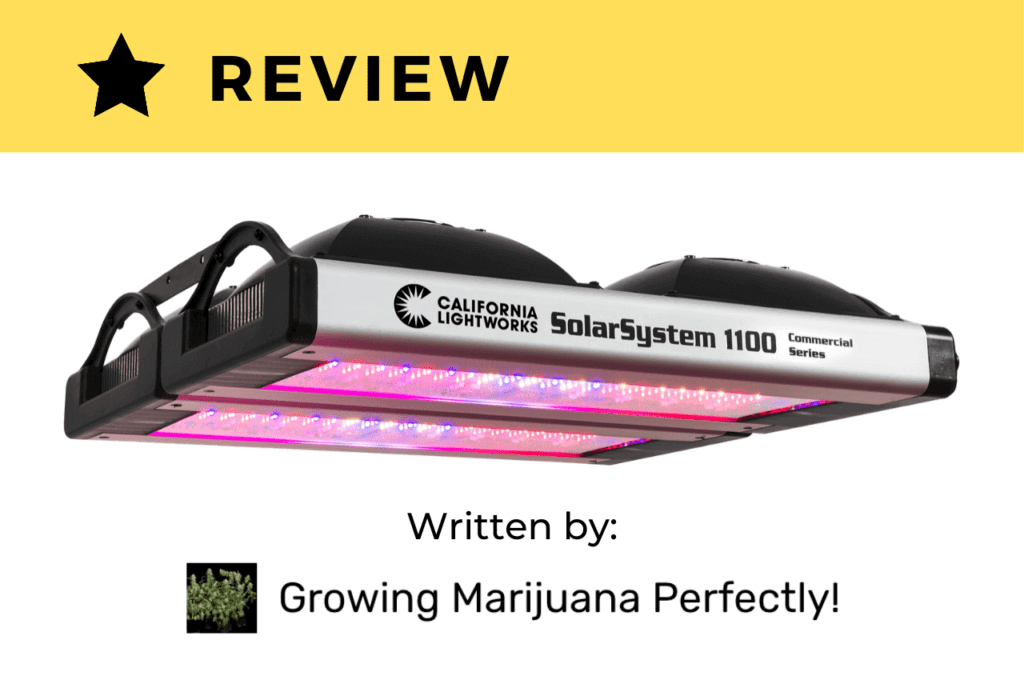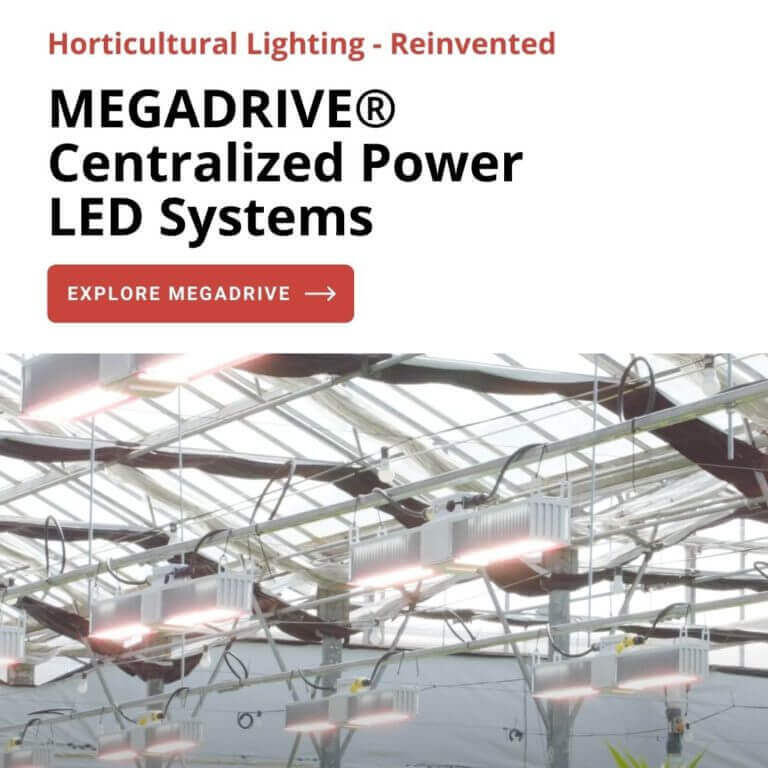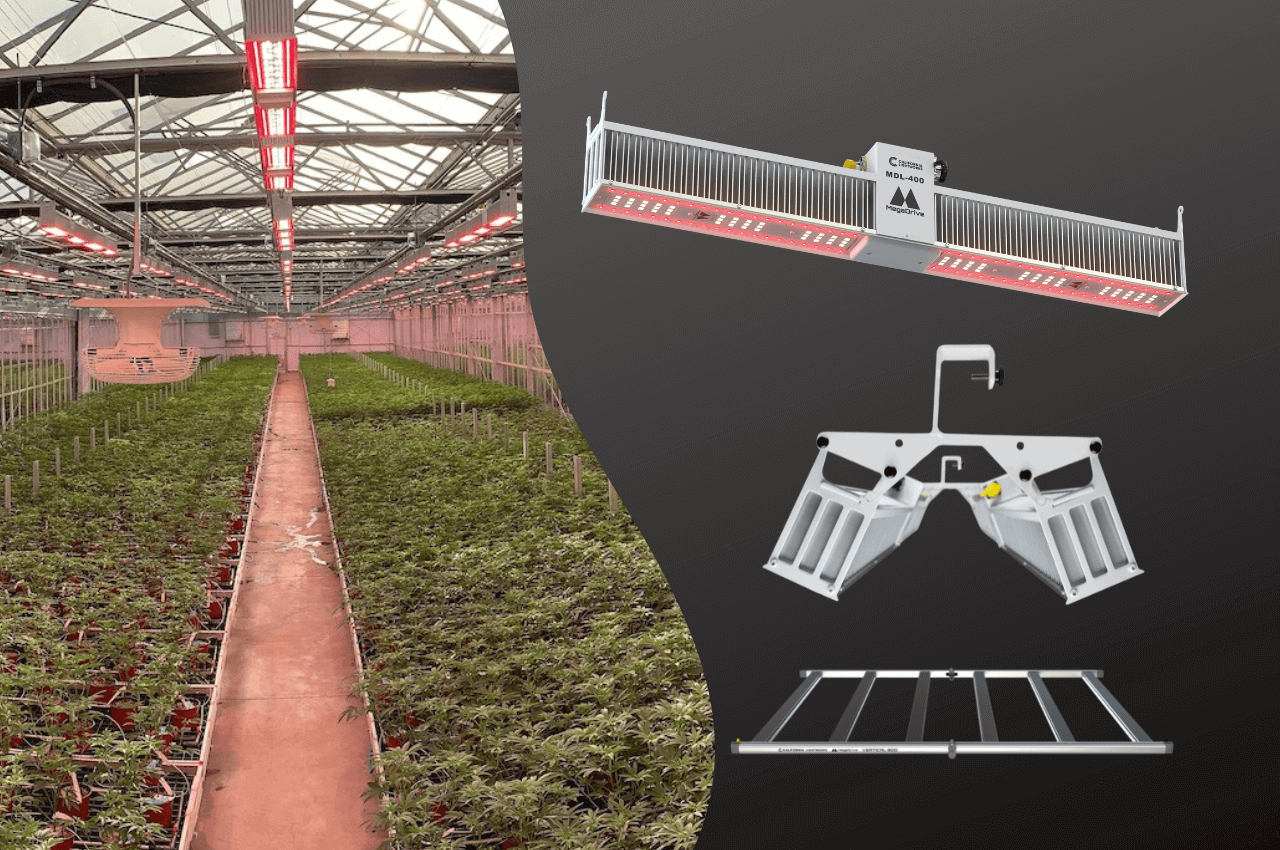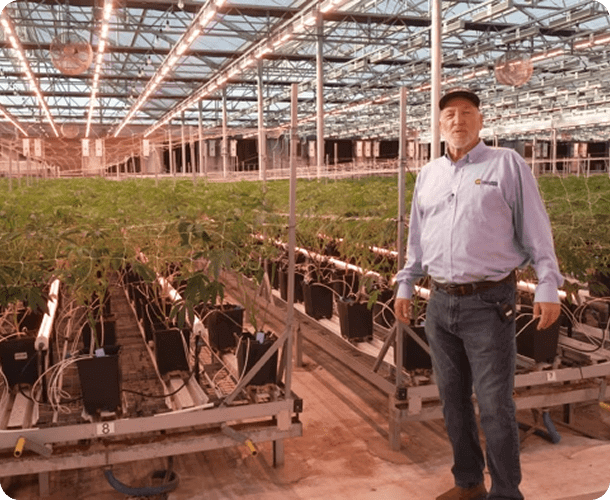I am on a mission to find the best grow light (This is a review by https://growingmarijuanaperfectly.com). Over the course of this decades-long project, I have tested nearly two dozen HID, LED, and plasma grow lights. My methods include individual testing as well as side-by-side comparison. I use uniform clones and other controls, careful to ensure my testing measures only the effect of the grow lights. So far, the SolarSystem 1100 by California Lightworks has literally outshined almost every other lamp I’ve tested. Let’s have a closer look at how SolarSystem 1100 Performs Against Other Grow Lights.
I got my hands on the SolarSystem 1100 early last year. I used the lamp alongside the SolarSystem UVB, a set of T-5 light tubes that attach to each side of the main fixture. I also acquired the SolarSystem controller, a digital spectrum control unit that can be pre-programmed up to 365 days.
California Lightworks is one of the top LED grow lights manufacturers in North America. It’s been on my grow light bucket list for a while. There are a couple premium brands I have yet to check out, including NextLight. But I can say for certain that I understand why California Lightworks ranks among the very best.
Based on my own testing, the SolarSystem 1100 stands among the top two in most categories. In some categories, it’s even a clear-cut number one.
If you’re wondering what California Lightworks has to offer, I’ve got you covered. I’m going to lay out everything a grower could possibly want to know about the SolarSystem 1100 and its manufacturer. I’ll also share my own experience with this lamp. And if you’re a newbie, I’ll share some tips about why some of the light’s best features are so advantageous.
Who is California Lightworks?
California Lightworks is (as one would guess) a California-based LED grow light manufacturer. While most grow light companies are operated by those who have no clue about cultivation or grow light physics (think venture capitalists), the founders and owners of California Lightworks are engineers.
This distinction is unsurprising when you consider the superlative design of their products. This includes specialized circuit boards as well as other features to minimize heat and maximize performance.
Because the owners are so personally invested grow light technology, they maintain a high standard. They only use 5-watt Osram diodes. If you’re new to LED grow light tech, Osram is The Premium diode maker. They out-perform even Cree and Philips in light output and efficiency.
In fact, 5-watt Osrams supposedly use half the heat and electricity as 3-watt chips while putting out twice as much light.
From high-end engineering to top-tier materials, California Lightworks has a proven dedication to excellence.
As for the specific light I tested . . .
How SolarSystem 1100 Performs Against Other Grow Lights: Top Features and Specs
The SolarSystem 1100 is the most powerful grow light in California Lightworks’ product line. It’s part of California Lightworks’ SolarSystem series.
All lamps in the SolarSystem series are engineered for commercial quality grows. This collection includes a wide range of lights, including lower power lights designated for grow phase, propagation, all-season, bloom phase, or small spaces.
I love this variety, as it accommodates a range of grow setups. From grow tents to huge indoor facilities, any grower can find a top-quality LED grow light appropriate to their needs.
Heat and Power
My tests have proven that this lamp equals or beats the yield, performance, and growth rate of 1000 watts of single-ended or double-ended HID bulbs. And it does so while using far less electricity and emitting significantly less heat. At maximum output, the SolarSystem 1100 draws only 800 watts. It also runs cooler than any comparable wattage grow light I tried.
The SolarSystem 1100 features a body and casing made of aluminum. This is already the most efficient heat sink material. According to California Lightworks engineers, they use much higher quality aluminum than their competitors. Based on their overall commitment to quality, I don’t doubt that’s true. The entire unit weight 26 pounds—plenty light enough for standard light movers and light stands.
Their heat sinks are also larger and more effective. For growers, this is a huge benefit. The more effective the heat sink is, the cooler the operation temperatures. With less heat degrading LEDs and components, the unit has a much longer life.
California Lightworks guarantees a minimum of 40,000 hours with little-to-no drop off in light output or quality. I haven’t been able to test that claimed lifespan for myself, but I did speak with multiple commercial growers who use California Lightworks lights. Sure enough, their lamps have run continuously for tens of thousands of hours with zero failure.
This is further proof of one of the most common claims for the superiority of LEDs. High quality LED grow lights are known for their longevity, making them a far better investment than HIDs. HID bulbs generally have to be replaced every couple grow cycles. Over time, those replacement costs add up.
Coverage
The angle of light dispersal can make a notable impact on the overall usefulness of LED grow lights. Of particular interest is whether the manufacturers place materials such as lenses to interface between LEDs and plants. The angle at which LED clusters are mounted into a frame influences the quality of coverage.
One common LED manufacturing technique is to put directional lenses or magnifiers on diodes. This narrows, focuses, and concentrates the angle and intensity of light. This may result in a light source so intensified that the lamp must hang far above the canopy to prevent light burn.
It’s also possible for a unit to have a dispersal area that’s too wide. Or the arrangement of diodes could cause hot spots and dark spots.
None of this is true about the SolarSystem 1100. This unit does not use magnifiers on its diodes. The light features a rectangular footprint and uniform dispersal throughout the coverage area. There is a perfect blending of the three color bands, creating an attractive bluish-white tone.
As for the size of the coverage area, there is some variability depending on how you use the light. Generally speaking, you can expect a coverage area of 17-23 square feet for the vegetative phase. For flowering, expect 13-18 square feet.
Why can’t I provide consistent and exact measurements? Because the SolarSystem 1100 gives you options. When used with the SolarSystem controller, you can adjust the ratio and intensity of the red, blue, and white color bands. The controller allows for incremental changes, from 0 to 99. As you adjust light intensity, you must also change your hanging heights, which in turn affects coverage area.
But the most important takeaway here is that whatever the coverage area is, you can count on an even, mixed spectrum at optimal intensity levels.
Dimensions
The SolarSystem 1100 unit is around 18” x 18” x 4”. If you add the optional T-5 UVB fixtures on either side (as I did), total size becomes 23” x 23” x 4”.
It’s also worth noting that there are cooling fans located on top of the unit; there is no passive cooling. Even so, the fans are surprisingly quiet . . . quieter than I’ve heard from an LED grow light.
Variable Spectrum Control: The SolarSystem 1100’s Claim to Fame
For my part, the most useful feature of the SolarSystem 1100 is the variable spectrum control. This is one of the most important advantages of the way SolarSystem 1100 Performs Against Other Grow Lights.
To understand the value of being able to infinitely adjusting color band intensity, you need to understand a few things about plant development and the options currently available in the grow light industry.
Many grow light manufacturers boast about delivering photosynthetically active radiation (PAR). But while PAR is essential for growing healthy plants, the spectrum variability of the 1100 goes further. When the grower can manipulate the light spectrum available to their plants, they can improve plant growth rate, health, and yield. They control flavor profiles and potency by doing more than stimulating photosynthesis.
This potential does not exist in HID grow lights. It doesn’t even exist in most other LED grow lights.
Where HID Grow Lights Fall Short
The only way to “adjust” the light spectrum of HID lights is to switch between metal halide, high pressure sodium, and ceramic metal halide bulbs. The range of wavelengths available in these bulbs is permanent and preset.
Additionally, I have yet to find an HID bulb engineered to provide the ideal spectrum for cannabis cultivation. The spectral output is typically over-focused on red, orange, and middle-blue. The design of these lights doesn’t just fail to optimize your plants’ growth potential. It’s also a waste of electricity, using more power to do a poorer job than LED grow lights.
In fact, when you can’t control the radiation from your grow lights, you can’t nourish your plants as precisely. Just as your plants consume mineral elements through their roots, they essentially “eat light” through their leaves.
Consider how different mineral elements influence different areas of plant development. Plants require different nutrients for functions such as plant growth, floral structures, metabolism, and cannabinoid production. This is why most growers use different base nutrients depending on their crop’s stage of growth. For example, you’d use phosphorus and potassium for flowering, but not for veg.
It’s the same story with light spectrum. You get tall, gangly plants when you use too much fertilizer nitrogen at the wrong time. A grow light spectrum heavy in red and orange has the same result. And yet, HPS bulbs used in bloom have a high red/orange output. MH bulbs—frequently used for growth—strongly favor blue wavelengths. In both cases, you get wavelength ratios that are not conducive to high yields and exceptional potency.
The Truth About How SolarSystem 1100 Performs Against Other Grow Lights
I contacted leading HID grow bulb manufacturers to learn more about the research between HID engineering. I asked for research demonstrating that their light spectrums optimize:
- Growth rate
- Structural integrity
- Budding
- Resin production
They had no research to show me.
Without any science from the manufacturers, I’m forced to point to my own findings. Over several years of personal photobiology research, I’ve found that almost all HID grow lights have too much red/orange and too little blue. I believe that while red/orange does have its place in cultivation, it also has its consequences. The bloom phase stretch is likely caused in part by excessive red/orange radiation from HPS bulbs. This promotes those long internodes.
Now, those who swear by HID grow lights often point to the large, gooey harvests they sometimes produce. But this success isn’t due to the nuance of the light. It’s simply the result of a light intensity overdose. HID bulbs blast your plants with an excess of photons. This saddles you with higher-than-necessary operational costs, including energy consumption, cooling, waste, and ventilation.
Variable spectrum LED grow lights like the SolarSystem 1100 offer a superior alternative. These lamps offer complete control over light wavelengths. You achieve high quality results through more intelligent methods. You can even manipulate the grow cycle to shorten your crop time.
Just be aware, you don’t get these benefits from any LED grow light.
Where Other LED Grow Lights Fall Short
High efficiency and low heat output are top benefits of pretty much all premium LED grow lights. However, many brands design their LED lights to mimic the spectral output of HPS bulbs. Once again, growers are stuck with that pink, red, or orange tint.
For this reason, other premium LED grow lights perform best during the grow phase. It’s in bloom that they fall short compared to the SolarSystem 1100. The variable spectrum design by California Lightworks allows you to provide the exact spectrum to promote heavy harvests and the most trichomes per watt.
It’s particularly notable, then, that the SolarSystem 1100 costs $200-400 less than lamps from other brands in the same prosumer class. The light also comes with a 5-year warranty and is backed by an uncommonly helpful technical support staff.
My Experience of How SolarSystem 1100 Performs Against Other Grow Lights
As I said, California Lightworks provides exceptional customer support. Through all my experiments, they were happy to answer questions and guide me through the nuances of the SolarSystem controller.
But as a starting point, they provide some basic guidance regarding light intensity settings. They break their advice down by plant life phases, with recommended spectrum settings for:
- Seedling
- Vegetative
- Pre-flower
- Peak bloom
- Finishing
For those who want to keep it as simple as possible, there are presents built into the controller. You can also expect a guide for using the SolarSystem UVB, should you choose to include it in your setup.
Experimenting with Spectrum Control of SolarSystem 1100
Your options are many with the SolarSystem controller. I was astounded by the complexity of its programmability. You can even daisy chain your lights to manage all of them with the same controller.
That said, I’m a low-tech guy. I stick to the basic function, using the controller primarily to incrementally adjust blue, white, and red diode channels. I initially tested the light using California Lightworks’ recommended wavelength recipes. In this process, I learned that light recipes are as nuanced and individual as hydroponics nutrients.
The ideal spectral mix of radiation depends on more than your plants’ current growth stage. Other influencing factors include:
- Genetics
- Type of growing system (soilless mix, deep water culture, etc.)
- Quality of environmental controls
- Multilevel grow room space
- Whether plants are seedlings, clones, or older
- Etc.
I quickly discovered that the manufacturer’s general light intensity recommendations were too much for my clones and seedlings. I overlit these young plants, causing downward and horizontal morphology as they grew away from the light.
These leads me to another important point for anyone interested in the SolarSystem 1100.
Light Intensity and Hanging Heights
Make no mistake: the SolarSystem 1100 is a powerful light. This is how you get great yields, but it’s also how your burn your plants if you’re not careful about intensity and hanging heights.
In the course of my experimentation, I learned to position the light 40-48” above clones and seedlings. Once they formed robust root systems and 3-5 sets of true leaves, I could expose them to higher light intensity. I also learned that these young plants thrived off a light intensity that’s only 65% of California Lightworks’ recommended dose. (As a side note, the SolarSystem 550—a less intense model—can be hung closer to the canopy.)
I continued using a scaled-back light intensity and greater hanging heights into the grow phase. Between my adjustable light hangers and the SolarSystem controller, it was extremely easy to experiment. As my plants grew, I could micro-adjust both spectral output and grow light height as necessary.
How did I know when and how to make these adjustments?
I carefully observed the condition of my plants’ leaves. Any sign of light or heat stress—bleaching, burning, etc.—is a clear indicator that it’s time to back off. This could mean raising the lights, reducing the intensity, or both.
How High Power SolarSystem 1100 Performs Against Other Grow Lights?
As long as we’re on the topic of light burn and intensity, let’s discuss the responsibility that comes of owning a SolarSystem 1100.
This is a highly advanced grow light system. It’s not an amateur-level plug and play system. You don’t have to be a commercial grower to use the light, but you do have to take cultivation seriously.
Many growers burn or bleach leaves their first time using professional grade LED grow lights like this one. This is because the cool temperature of these lights complicates your perception of light intensity, especially if you’re used to working with searing hot HID lights. This is why it’s important to observe your crop closely. Learn to recognize LED leaf burn so you can make adjustments to your setup.
If you are genuinely passionate about growing, the SolarSystem 1100 is one of the most satisfying grow lights you can use. I am amazed with how SolarSystem 1100 Performs Against Other Grow Lights. The versatility of this lamp allows for ongoing experimentation, adaptability, and discovery. Ultimately, you have the opportunity to craft the optimal radiation spectrum for your crop.
I had this experience when I adapted California Lightworks’ recommended red channel dosage according to my research. I found that the red/orange dosages that come standard with most grow lights create unfavorable outcomes.
One such outcome is long internodes, a problem I battled with this particular crop. So, I increased blue and white in the bloom phase. The result? Shorter internodes and no more stretch.
After experimenting during the grow phase, I found the sweet spot at about 30 inches from the canopy. That’s at least a foot closer than the original placement. My blue-dominant customized spectrum helped me achieve shorter, stockier growth to accommodate more buds. This also helped ensure sufficient light penetration.
The overall benefits of intelligent use of the SolarSystem 1100 include:
- Increased growth rate
- Faster flowering
- Faster bud development and maturation
- Shorter harvest cycles
Translation: Much higher yields per cycle and more cycles per year.
The SolarSystem UVB & SolarSystem 1100 Against Other Grow Lights
According to research, a dose of UVB rays just before the dark cycle causes higher production of cannabinoids and terpenoids. I tested this using the SolarSystem UVB.
I used the optional UVB kit from California Lightworks, positioning UVB tubes on either side of the main unit. I activated these lights for the last three cycle hours of each day during peak and late bloom.
Combined with the high intensity and spectral quality of these lights, the UVB gave me outstanding results. Overall, the SolarSystem 1100 and UVB consistently produced yields of nearly one gram per watt . . . possibly more. Compared to HID bulbs, I harvested stickier, denser buds with more resin glands and less stalk, stem, and leaf with the SolarSystem 1100.
And I’m not done the experimenting. A research scientist recently told me about the benefits of running UVB light for a few hours during the lights-off cycle. Doing this supposedly increases cannabinoid and terpenoid production. I look forward to testing this using the SolarSystem UVB and see how SolarSystem 1100 Performs Against Other Grow Lights using UVB lights.
The Bottom Line
I can safely say I was impressed with how SolarSystem 1100 Performs Against Other Grow Lights.
If you’re thinking of switching to LEDs from HIDs, this particular unit is a worthwhile replacement for 1000-watt HID bulbs. You get:
- A 30-50% drop in operating costs
- Harvest weight outcomes comparable to or minimally lower than HID
- High cannabinoid and terpenoid percentages
- Precision control over light spectrum
If you’re working within a grow tent or any other space with limited multilevel height, check out the rest of the California Lightworks collection. In close quarters, the high intensity of the 1100 would be overkill. For commercial growers or full-size photoperiod plants in a spacious grow room, the SolarSystem 1100 is a stellar investment.
Don’t be deterred by price. These lights are pricier than a 1000-watt HID setup. That’s true of any professional LED lamp. But you save loads over time between the 40,000-life and massive reduction in wattage consumption and cooling costs. After a few grow cycles, these lights pay for themselves.
They are also cooler and quieter than HID lamps. They represent the most advanced cultivation tech on the market. And perhaps most importantly, they’re fun to own and operate.
Finally, their customer service truly is among the best you’ll find. When you speak with Adam (tech support) or Craig Adams (VP, Marketing & Sales), you understand why California Lightworks produces the quality they do. The guys running the show are grower-centered. They readily share insights and provide candid advice. I got the sense they were as invested in my crop as I was!
If you’re curious to learn more about bow SolarSystem 1100 Performs Against Other Grow Lights, I highly recommend reaching out to the team at California Lightworks. They’ll help you find the right grow light for your room, personal or professional, large or small.




![[Case Study] How Sunburst Nurseries Used MegaDrive® To Speed Up The Propagation Of Dragonfruit Plants](https://californialightworks.com/wp-content/uploads/2022/05/sunburst-nurseries-used-megadrive-technology.png)
![[Case Study] How Nipomo Ag Used MegaDrive® To Save Money & Improve Yields](https://californialightworks.com/wp-content/uploads/2022/04/nipomo-ag-used-megadrive.png)
